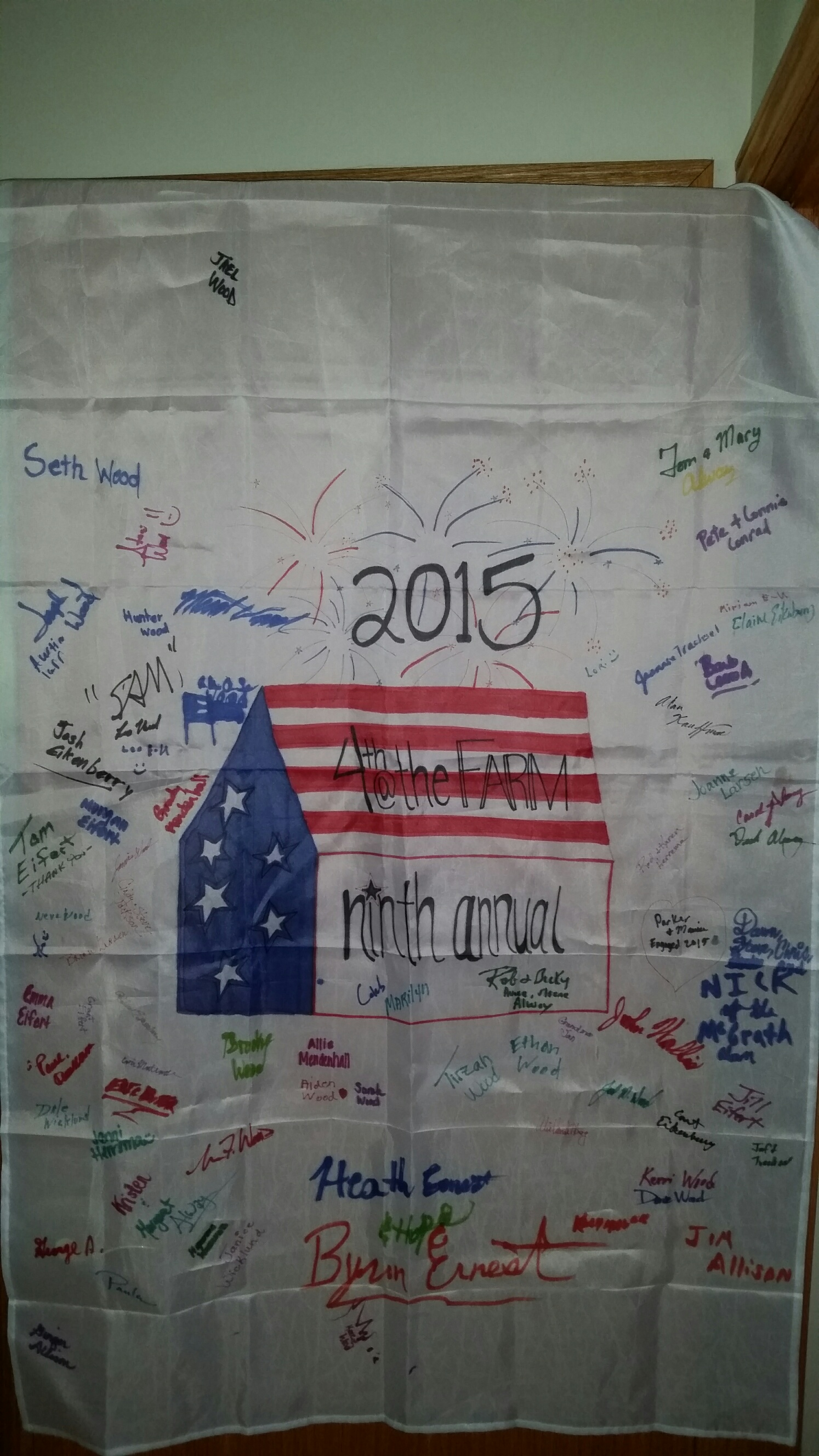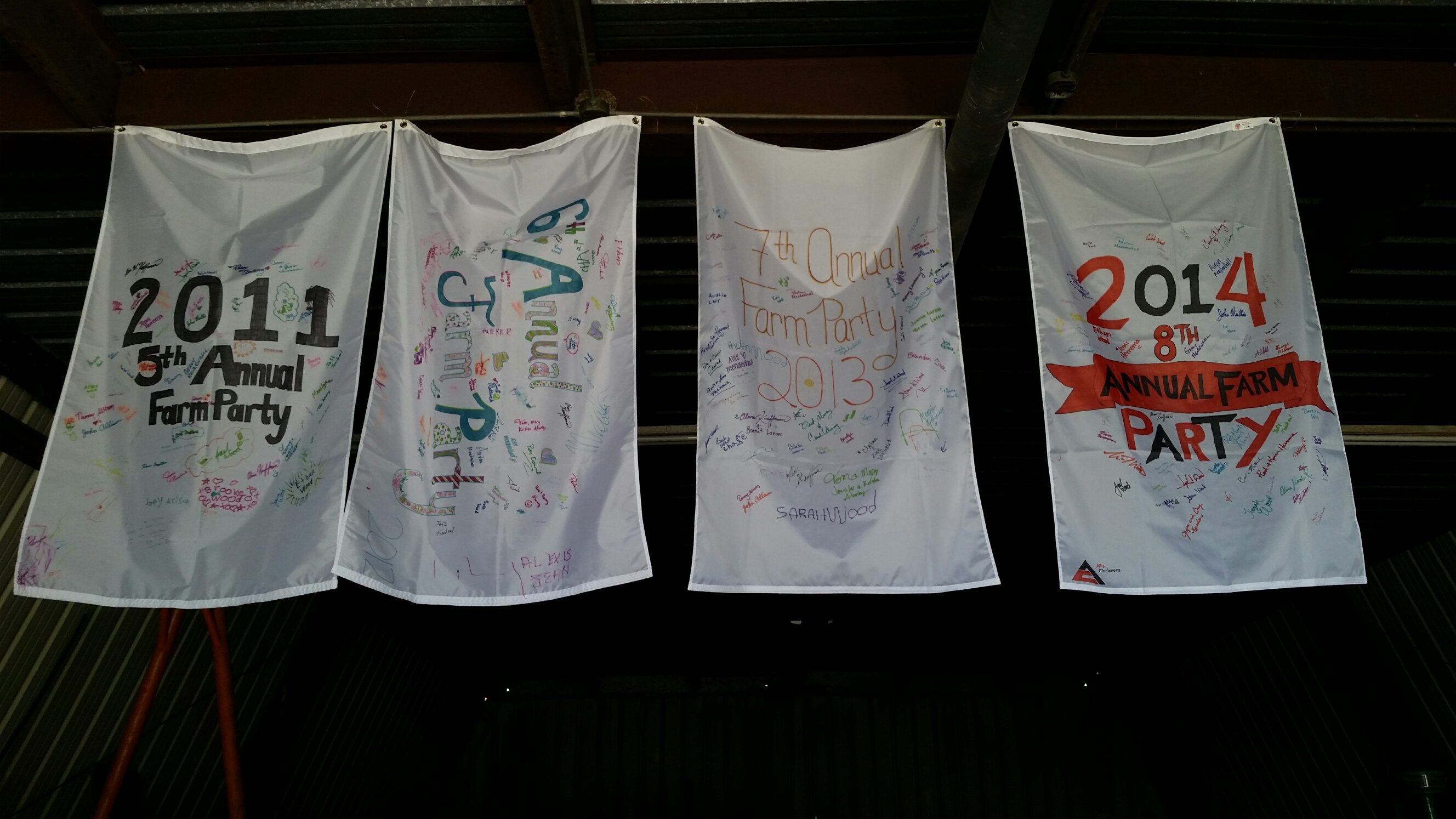 Before I get to the lessons, I need to give you a bit of background. On July 4th, we hosted the ninth annual Farm Party at our farm in Michigan. The flag you see in the picture was signed by nearly all of the 88 attendees of this event. (The other picture shows the flags from the last four years, hanging as banners in our shop.)
Before I get to the lessons, I need to give you a bit of background. On July 4th, we hosted the ninth annual Farm Party at our farm in Michigan. The flag you see in the picture was signed by nearly all of the 88 attendees of this event. (The other picture shows the flags from the last four years, hanging as banners in our shop.)
The first party wasn’t nearly that large – just a few people in the yard the summer my Dad passed away. The reason for the first one was that my sister and I, who both live far from the Farm, were both going to be in town at the same time. We had no idea then that it would become an annual event, or how it would grow in size, scope and meaning.
Beyond my sister and my families, we now have people coming from across the road and as far away as 320 miles to attend. The guests included children less than one year old and at least one person over 80. This year there were six RV’s and seven tents around the property. There was (lots of) food, fellowship, horseshoes, basketball, (hundreds of) water balloons, (four) hayrides, fireworks, a (six hour) bonfire and even a late-night, post-fireworks snack featuring bacon – a new tradition added last year by a close friend.
So with that small peek into what it is, here are some lessons I learned from this year’s party/weekend.
……….
Important note: If you have read this far, please don’t take this (only) as a sentimental article from me. The lessons that follow apply to all of us, and as we recognize these things and work to add more of them to our work and life, we will be more effective and successful.
………
The Meaning of Tradition
If something wasn’t working, I can’t imagine it lasting nine years. But traditions that build do so because of shared meaning. Yes, the party started opportunistically to celebrate my Dad’s life. This event doesn’t really have attendees, it has participants. The meaning is different now to different people, but the meaning is what makes it a tradition. Now it is something that kids have grown up with, that people rearrange their calendars and vacations for, and that people look forward to.
Look for things that matter to people and help create ways for that meaning to be expressed. Ask yourself these questions:
What traditions do we have that matter?
How could we add traditions, with the stability they add, to balance the ever-changing world of our businesses?
The Value of Shared Experiences
After nine years, you can imagine there are some stories that are told from previous years. There are parts of the party (like shooting water balloons for example) that have grown organically and taken on a life of their own. Part of the value of the event is the re-telling of old stories, and the creation of new ones. Not just stories though, it is the living of the events together that bring people together.
In business, we too often forget about or under-value the gathering of people and what is gained by the common experience. Ask these questions:
How can we create shared experiences for our team or organization?
What existing shared experiences can we use to promote teamwork, collaboration and trust?
The Power of Community
This event started with family; where relationships already existed. Over the years, more family have come from farther away – and relationships have been strengthened,  rekindled, and even formed from this event. Now it is far more than family, and it is really more than “just” relationships. It is community. It is people building relationships, welcoming new people in and creating a common bond that is renewed during a party, but that extends all year long.
rekindled, and even formed from this event. Now it is far more than family, and it is really more than “just” relationships. It is community. It is people building relationships, welcoming new people in and creating a common bond that is renewed during a party, but that extends all year long.
Organizationally we think about team building, and there is nothing wrong with that; but when we can create a community, we have created something far stronger and more resilient. Ask these questions:
When have I experienced community and what can I take from that personally and professionally?
How can I create opportunities to intentionally build communities in my organization?
The Fun in Collaboration
Perhaps it goes without being said that putting together this event takes some effort (especially when the planners live hours away). Yes, there is planning, and yes, there is much set up involved. I can honestly say now that the setup is almost as much fun as the party – we have tasks to do – but we have fun doing them! The list of people who come early with the expressed purpose to help prepare is about 10% of the total party population. Some (mostly different) people come help with clean up on Sunday or Monday. None have ever been asked. All volunteer. Most have already told me they will be early to help next year.
Collaboration can be fun at work too, and not just for a party. Ask these questions:
How often do we have fun at work?
What could we do to have more of it?
I have more lessons, but these float to the top as the most universally-applicable for all of us as leaders in organizations. Through this article you probably have more of a glimpse of our party. More importantly I hope you have some challenging questions to ask – and answer – to help your team and organization be more effective.

What a great article. I love the sincerity of it as well as the practicality of it. Community starts with relationships and ends memories that last. Thank you, Tracie
Hi Tracie – Glad you enjoyed it! Community DOES start with relationships. Thanks for the comment 🙂